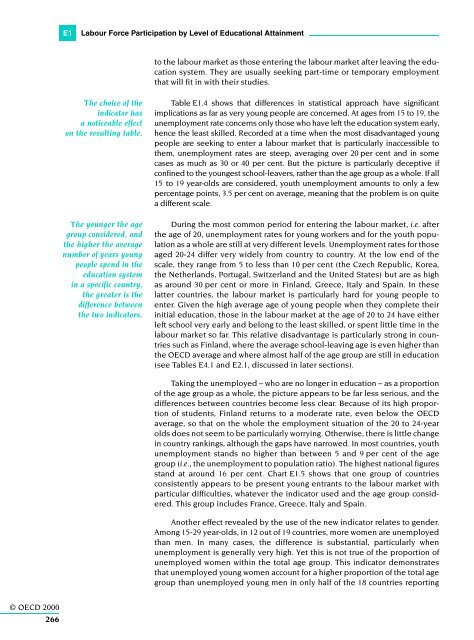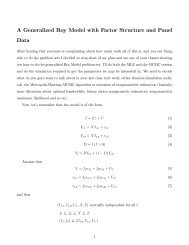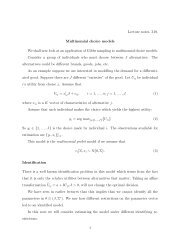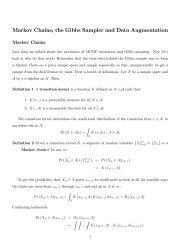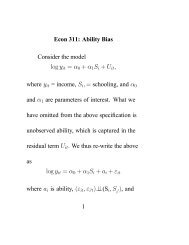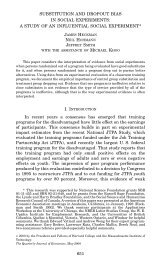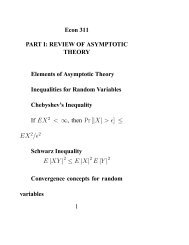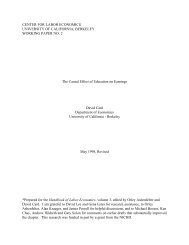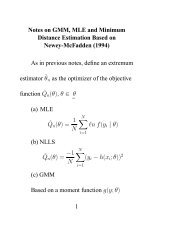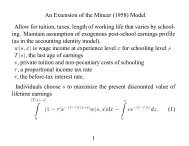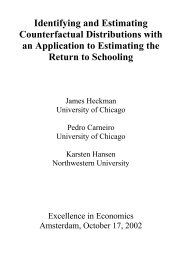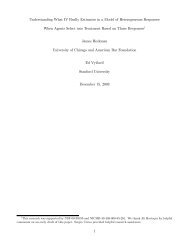OECD (2000)
OECD (2000)
OECD (2000)
You also want an ePaper? Increase the reach of your titles
YUMPU automatically turns print PDFs into web optimized ePapers that Google loves.
E1<br />
Labour Force Participation by Level of Educational Attainment<br />
to the labour market as those entering the labour market after leaving the education<br />
system. They are usually seeking part-time or temporary employment<br />
that will fit in with their studies.<br />
The choice of the<br />
indicator has<br />
a noticeable effect<br />
on the resulting table.<br />
The younger the age<br />
group considered, and<br />
the higher the average<br />
number of years young<br />
people spend in the<br />
education system<br />
in a specific country,<br />
the greater is the<br />
difference between<br />
the two indicators.<br />
Table E1.4 shows that differences in statistical approach have significant<br />
implications as far as very young people are concerned. At ages from 15 to 19, the<br />
unemployment rate concerns only those who have left the education system early,<br />
hence the least skilled. Recorded at a time when the most disadvantaged young<br />
people are seeking to enter a labour market that is particularly inaccessible to<br />
them, unemployment rates are steep, averaging over 20 per cent and in some<br />
cases as much as 30 or 40 per cent. But the picture is particularly deceptive if<br />
confined to the youngest school-leavers, rather than the age group as a whole. If all<br />
15 to 19 year-olds are considered, youth unemployment amounts to only a few<br />
percentage points, 3.5 per cent on average, meaning that the problem is on quite<br />
a different scale.<br />
During the most common period for entering the labour market, i.e. after<br />
the age of 20, unemployment rates for young workers and for the youth population<br />
as a whole are still at very different levels. Unemployment rates for those<br />
aged 20-24 differ very widely from country to country. At the low end of the<br />
scale, they range from 5 to less than 10 per cent (the Czech Republic, Korea,<br />
the Netherlands, Portugal, Switzerland and the United States) but are as high<br />
as around 30 per cent or more in Finland, Greece, Italy and Spain. In these<br />
latter countries, the labour market is particularly hard for young people to<br />
enter. Given the high average age of young people when they complete their<br />
initial education, those in the labour market at the age of 20 to 24 have either<br />
left school very early and belong to the least skilled, or spent little time in the<br />
labour market so far. This relative disadvantage is particularly strong in countries<br />
such as Finland, where the average school-leaving age is even higher than<br />
the <strong>OECD</strong> average and where almost half of the age group are still in education<br />
(see Tables E4.1 and E2.1, discussed in later sections).<br />
Taking the unemployed – who are no longer in education – as a proportion<br />
of the age group as a whole, the picture appears to be far less serious, and the<br />
differences between countries become less clear. Because of its high proportion<br />
of students, Finland returns to a moderate rate, even below the <strong>OECD</strong><br />
average, so that on the whole the employment situation of the 20 to 24-year<br />
olds does not seem to be particularly worrying. Otherwise, there is little change<br />
in country rankings, although the gaps have narrowed. In most countries, youth<br />
unemployment stands no higher than between 5 and 9 per cent of the age<br />
group (i.e., the unemployment to population ratio). The highest national figures<br />
stand at around 16 per cent. Chart E1.5 shows that one group of countries<br />
consistently appears to be present young entrants to the labour market with<br />
particular difficulties, whatever the indicator used and the age group considered.<br />
This group includes France, Greece, Italy and Spain.<br />
Another effect revealed by the use of the new indicator relates to gender.<br />
Among 15-29 year-olds, in 12 out of 19 countries, more women are unemployed<br />
than men. In many cases, the difference is substantial, particularly when<br />
unemployment is generally very high. Yet this is not true of the proportion of<br />
unemployed women within the total age group. This indicator demonstrates<br />
that unemployed young women account for a higher proportion of the total age<br />
group than unemployed young men in only half of the 18 countries reporting<br />
© <strong>OECD</strong> <strong>2000</strong><br />
266


